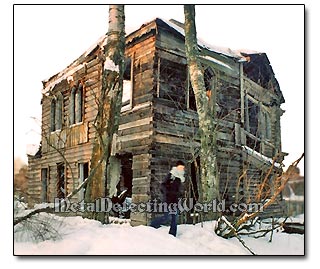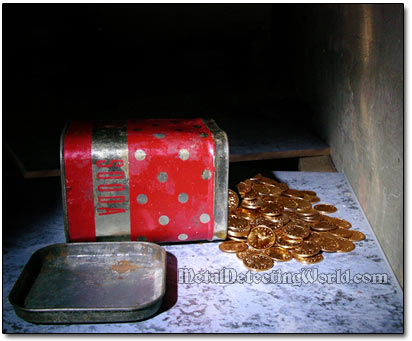Types of Metal Detecting Activities, page 11:
CACHE HUNTING TYPE III - Searching for Reported Caches of Valuables
General Information and Tips
This type of cache hunting involves serious research to pinpoint an exact location of a large coin cache that was buried by either an individual (a hermit, miner, prospector, bootlegger, wealthy person, etc.) or a group of people (road gangsters, bank robbers, pirates, etc.) and then reported or mentioned in newspapers, books or personal diaries.
These documented treasure caches are of special interest to professional cache hunters and could be hidden anywhere - their locations range from the old back yards to the remote spots situated away from populated areas.
In this type of cache hunting, 90% of the total time should be spent for research and only 10% of time should be spent for recovering the treasure. The research requires long visits to archives and libraries, endless browsing of the Internet and talking to local old-timers. The researcher must be good at being a detective, be objective, and use analytical way of thinking to separate a few good solid leads from fabled BS (treasure atlases, treasure guides and books on treasure legends, for instance).

These "You-May-Become-Rich-Overnight" books are written for the "arm-chair treasure hunters" and daydreamers who drool over treasure legends, fairy-tales and far-fetched assumptions that have been built up on incomplete or biased research done by the amateurs. The best thing these books can do is to bring many tourists to town (village, county, state) and boost the local economy.
When you come across any of these entertaining books, keep in mind that a number of professional treasure hunters conducted their research when the leads were still "hot" and successfully recovered these treasures long before they were publicized in every "treasure atlas". The golden rule of successful cache hunting is to be the first to obtain a "hot" lead and follow it fast. Metal Detectors required for this and other types of Cache Hunting are described on next page.
CACHE HUNTING TYPE IV - Searching for Coin Caches Hidden inside Old Deserted Houses and Buildings
The endless list of secretive places suitable for hiding coin caches and valuables inside any deserted house is beyond the scope of this article, but a few aspects of this type of cache hunting should be mentioned.

First of all, regular land metal detectors are not the best means to locate metallic valuables and coins stashed inside any house. Simply because the house is full of various sources of metal such as large and small iron nails in floor boards and wall frames, electric wiring and pipes running throughout the structure, etc.
If you plan to do electronic search of the house, your best choice are the hand-held scanners or low-sensitivity mini detectors. They are usually non-motion (they do not require a movement to get a signal), have no discrimination (operating in All Metal mode), utilize both audio and visual (LED) target response indicators, and their tuning threshold is automatically maintained.
These hand-held scanners are quite effective in detecting coin caches hidden inside the house walls or behind bricks or stones of cellar walls. Even if you hold a mini detector at predetermined distance from nail heads, its low sensitivity will ignore the nails and still provide ample detecting depth for larger hidden objects. Operation in All Metal mode insures that valuables placed in tin cans will not be ignored.
If you do not have a hand-held scanner or mini detector, you can use your regular detector with a small search coil called "sniper" - 6-inch or less in diameter, for searching the house. Here is a trick: you do not use your detector fully assembled. Instead, you attach the "sniper" coil to your hand with a duct tape and connect it to the detector's control box. This will give you comfort, increase your efficiency and speed up the process. Your detector should be operated with minimum discrimination settings.
Using a fully wireless metal detector, like XP Deus, makes the process of scanning the house walls, floors, ceilings and furniture times faster because you can move and maneuver the search coil without getting entangled with the headphones' and search coil cords. And if you tie the search coil to a rope, you can lower it 60 feet down into narrow, confined spaces. What makes the wireless detector the most effective instrument for the house cache hunting is that even if you use a 9-inch coil (XP Deus), your ability to locate a stash of treasures in between the iron nails or electrical house wires will not be diminished due to the coil's Double-D type, advanced technology and superfast Recovery Speed of the Deus metal detector itself.
Before you scan the cellar walls with a mini detector or if you conduct non-electronic search, use the "Black Light" (or Ultra Violet (UV) light) lamp to locate those spots on the walls that have been repaired or tampered since after the walls were finished. These spots are not always visible to the naked eye and could indicate the possible hiding places for coin caches. Black Light lamp emits electromagnetic radiation that is almost exclusively in the soft near ultraviolet range. Always use the black light with caution as the powerful ultraviolet sources present a hazard to eyes and skin.
While searching the house, look for loose boards on the floors and walls, and loose ceiling panels. Knock on the hard surfaces and listen for difference in sounds which could indicate a hollow space that could contain anything but the original materials used for construction. And never ignore the old furniture which likely may have a few secret compartments.
And always inspect the obvious. Once I found a large tin can full of silver Half-Dollars in an abandoned house which had already been searched a few times before I got there. I discovered this coin cache in a plastic grocery bag that was hanging on the back of the magazine/newspaper rack! None of previous searchers even bothered to look at the cheap framework...
